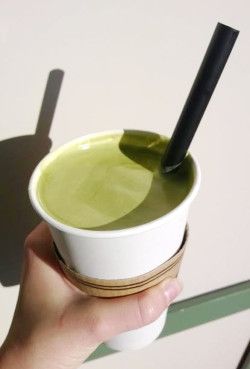Kung Fu Tea: Matcha Green Tea – The Bite

THE BITE: Kung Fu Tea is a bubble tea chain that has been spreading, with several locations in Queens, a few around Manhattan and Brooklyn, and locations in four other states. Sheepshead Bay’s own Kung Fu Tea is at 1422 Avenue U, just off East 15th Street.
Bubble tea originated in Taichung, Taiwan, in the 1980s. The “bubble” part of the name is an Anglicized form of “boba” which refers to tapioca pearls in the tea, and is Chinese slang for “large breasts.” Finding this out creeped me out a little. Bubble tea comes with a handful of boba at the bottom of the cup, which are not very large, but slimy-on-the-outside, chewy-on-the-inside balls of starch. Also, bubble tea has primarily been fashionable with young people, including kids.
In any case, it’s up for debate which tea house in particular came up with it, but bubble tea was first made with hot tea and tapioca pearls, mixed with milk and sweet syrup. The trend spread through East and Southeast Asia during the 1990s, becoming popular in Western culture as well during the past decade. Menus now include options of fruit flavors added as syrups or blended fresh fruits, powdered or fresh milk, powdered or brewed green, black or white tea, or no tea at all, or coffee, a variety of additional toppings such as red or mung beans, jelly cubes in different flavors and shapes, pudding in the bottom of your cup, not to mention different sizes and flavors of tapioca pearls. Your options will depend on which tea shop you’re at, but basically, the choices have become endless. At Kung Fu Tea you can specify if you want less, little, or no ice, and less, little, or no sugar. Freedom like this can be exhilarating and exhausting.
Something of a scandal broke out in 2011, when DEHP, a chemical used to make plastic and thought to be carcinogenic, was found in some of the Taiwanese syrups used to make bubble tea that had also been exported internationally. Rest assured, health officials have instructed companies to stop the sale of these syrups, and further inspection has since been done to ensure safe sales and consumption. Furthermore, a German study was done on Taiwanese bubble tea products in 2012 and found no harmful contaminants or health threats, however bubble tea popularity may have waned due to these health concerns.
On my recent visit to Kung Fu Tea, I went with a cup of warm matcha green tea, and lucky readers, here comes today’s second topic for a pertinent mini-history lesson. Long before bubble tea was in existence, green tea was being consumed around Asia in various forms. The oldest evidence is from around the year 600 in China. Green tea is picked from the young, new leaves at the top of the tea plant that are greener than the older leaves at the bottom.
Traditionally they were laid out to dry in the shade to avoid burning in the sun, though now the drying is usually done indoors. The younger and more tender the leaves, the higher the quality of tea that will result. To make matcha, the dried green leaves are put through a granite grinder to make a fine, bright green powder that can be whisked into hot water to make matcha tea. The finer the powder, the finer the tea is considered to be. Nowadays matcha is also used to make a host of other drinks such as lattes and shakes, and in foods such as noodles, cakes, and ice cream.
Matcha has seen a rise in popularity in the West recently, making its way into mainstream foods and drinks as mentioned, and lauded for its health benefits. A 2003 study at the University of Colorado found high concentrations of chlorophyll, catechins, and antioxidants including EGCG in matcha, possibly owing to the fact that the entire leaf is consumed and not just trace amounts of plant matter as would be the case with steeped tea leaves.
The photo you’re looking at is a sturdy cup of warm matcha with tapioca pearls and red beans. A medium (16 ounce) with two toppings cost me $5.50 (think of it as an adventurous alternative to Starbucks and maybe it won’t sound quite as pricey anymore?). It was frothy and had that toxic-green color that I like because it somehow tricks my brain into thinking I’m drinking something healthy even though I know I ordered it with the full amount of sugar.
It was made with fresh milk (not powdered) and quality matcha, evident by the smooth non-gritty consistency. The tapioca was the standard black quarter-inch pearls, slightly sweet with a uniform chewy consistency. The red beans were also a bit sweet but not syrupy or too mushy, though a little hard to get to even with the giant straw; a spoon would have been helpful at the end.
Kung Fu Tea, 1422 Avenue U, (718) 819-9079.
— Sonia Rapaport
The Bite is Sheepshead Bites’ weekly column where we explore the foodstuffs of Sheepshead Bay. Each week we check out a different offering from one of the many restaurants, delis, food carts, bakeries, butchers, fish mongers, or grocers in our neighborhood. If it’s edible, we’ll take a bite.




